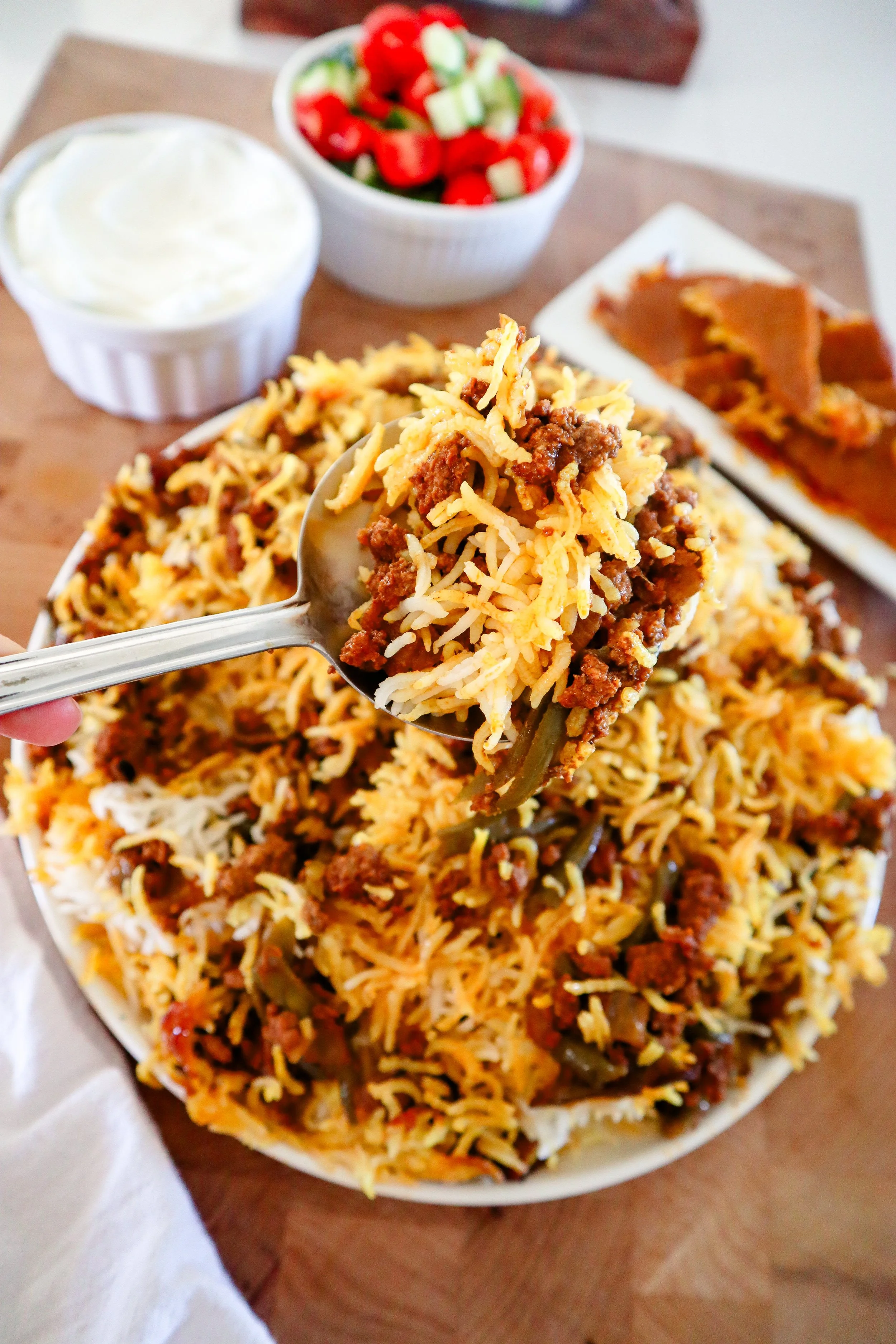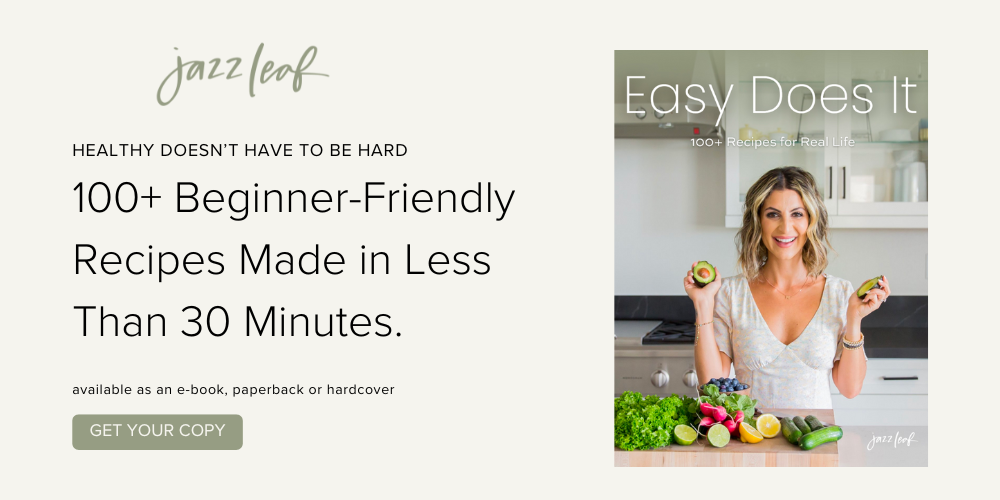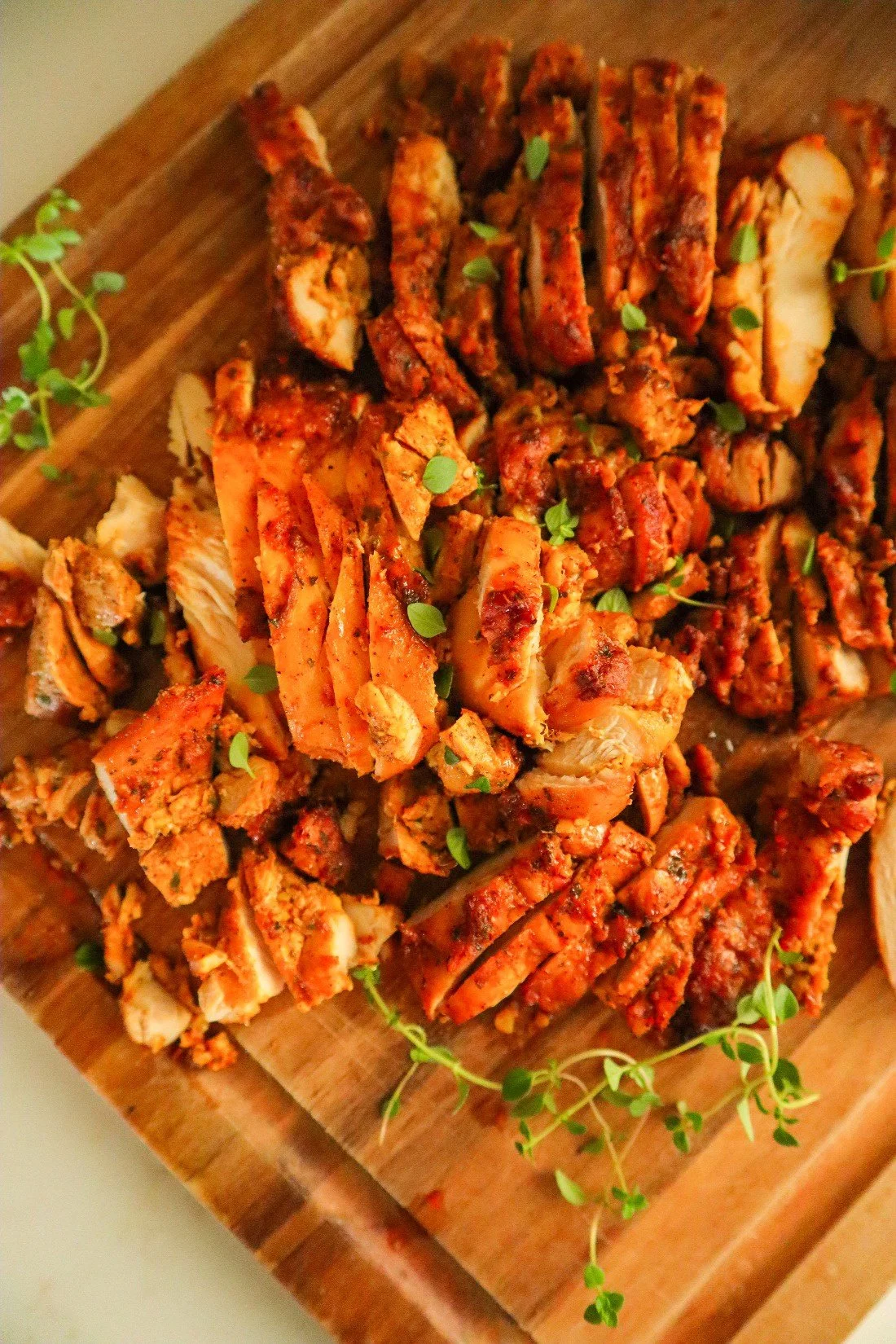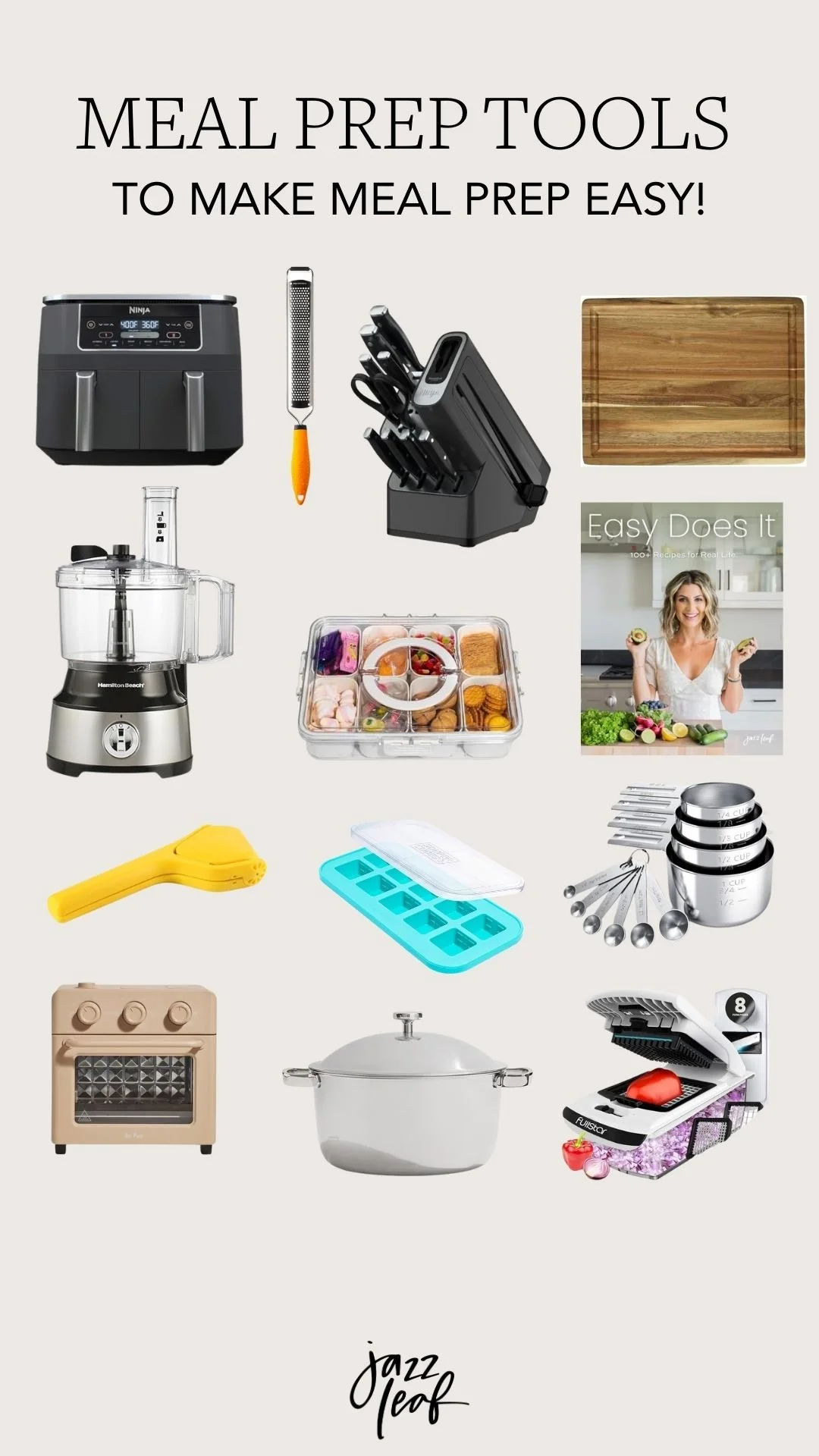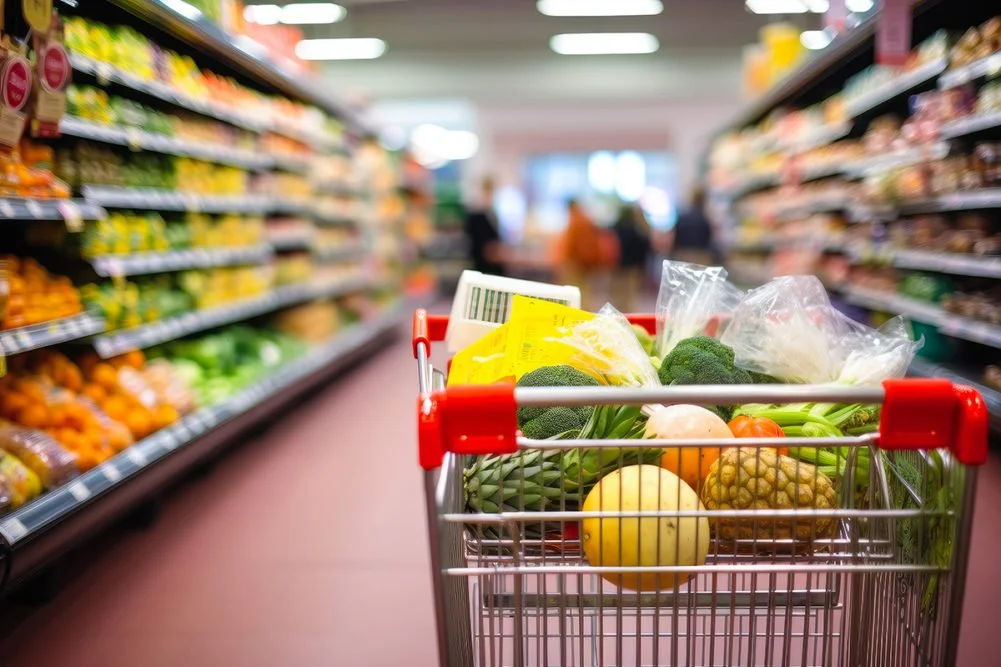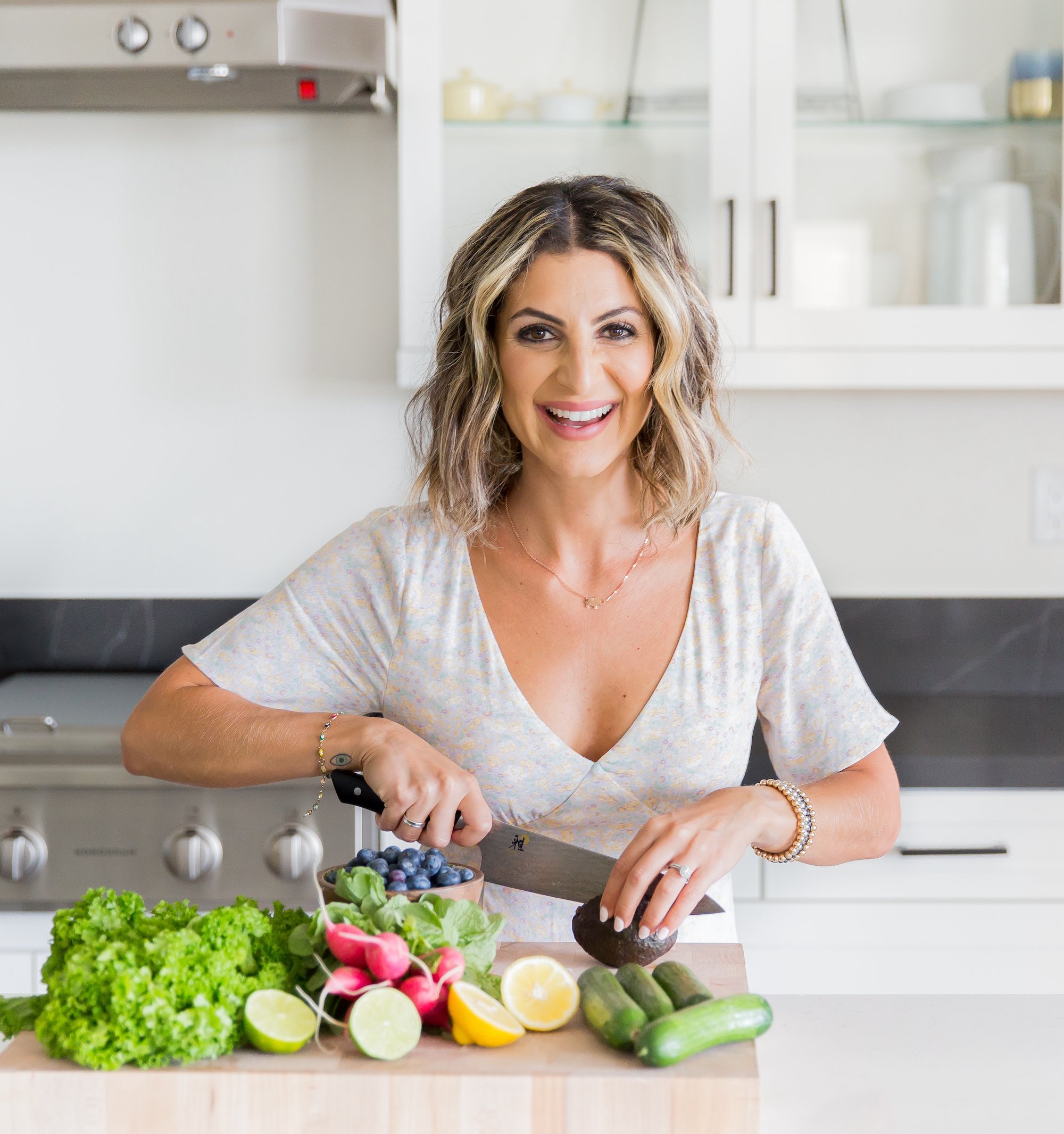Budget Grocery List & Guide for Healthy Eating
Let’s be real, figuring out what to buy and where to buy it can feel overwhelming. I used to walk into the store and second-guess everything, from bulk items at Costco to the best finds at farmers markets and smaller grocery stores like Sprouts or Trader Joe’s.
That’s exactly why I put together this simple guide for you! It’s my budget grocery list that shows you what I like to grab from bulk stores versus what I usually pick up locally. You can download it and bring it with you to make shopping easier, save money, and stock up on healthy, affordable staples.
I’ve also included a roundup of Budget-Friendly Trader Joe’s Recipes from my blog, complete with ingredient price breakdowns, plus a list of my favorite meal prep tools to make prepping food faster and more efficient.
Think of this guide like having a friend walk you through their grocery routine! Keep reading to find out all my tips and tricks to budget grocery shopping while also eating clean!
Why You Need a Budget Grocery List
A budget grocery list gives you a clear plan so you don’t overspend or waste food. It keeps you focused, which means you’re less likely to throw random things in the cart just because they look good in the moment. By sticking to your list, you’ll avoid impulse buys, only get what you actually need, and save real money over time. It also makes grocery trips quicker and way less stressful.
Check Out My Cookbook!
Jazz's Money-Saving Tricks!
Saving money on groceries is all about strategy and consistency. These smart habits will help you keep food costs low without sacrificing quality or flavor. Here are all of my best tips:
1. Shop Your Kitchen First
Before heading to the store, shop your fridge, pantry, and freezer. Take a quick inventory of what’s close to expiring, like that bag of spinach or half-used pasta sauce, and build your upcoming meals around those ingredients.
Keep a running list on your phone of pantry or freezer staples as soon as you finish them so you can restock efficiently. You’ll save money by avoiding duplicates and prevent food waste at the same time.
Pro tip: Freeze odds and ends like herbs, broth, or leftover tomato paste so they don’t go bad before you use them.
2. Take Advantage of Weekly Deals
Most grocery stores share weekly sales through flyers or apps. I always check the weekly ads when building my shopping list. By supplementing your groceries with items on sale, you can significantly lower your total bill over time.
Pair this with your kitchen inventory so you’re buying what complements what you already have, not random impulse buys.
3. Don’t Shop Hungry
This is the simplest trick in the book: never grocery shop on an empty stomach. Hunger leads to impulse purchases that can blow your budget fast. Eat a meal or snack beforehand to keep your list and spending under control.
4. Keep Versatile Basics in the Pantry
A well-stocked pantry makes meal planning easy and helps you stretch your budget. Some essentials to keep on hand:
Grains like oats, rice, or quinoa, which work for breakfast, lunch, or dinner
Canned goods such as beans, tomatoes, and broth, perfect for soups, chilis, or quick bowls (and shop them when they’re on sale)
Flavor builders like nut butters, olive oil, vinegar, and spices such as garlic powder, cinnamon, and chili flakes
Tortillas or wraps, which are endlessly versatile for tacos, pizzas, or quick roll-ups
Buying these in bulk during sales helps you save even more.
5. Maximize Your Freezer Space
The freezer is one of the best tools for saving money when used smartly.
Freeze soups and sauces flat in bags so they stack neatly
Label everything with the date to avoid mystery meals
Portion before freezing so you can thaw only what you need and reduce waste
Freezing is also a great way to extend the life of produce, like peaches for smoothies or spinach for sautés.
6. Be Strategic When Shopping at Costco
Costco is great for savings, but bulk buying requires a plan.
Make sure you have space to store everything
Only buy fresh items in bulk if you know you’ll use them before they spoil
Always check unit prices to make sure the bulk deal is truly a better value
Focus on non-perishables or long shelf-life items like rice, oats, pasta, frozen fruit, vegetables, or meat. These are things you use often and can store safely.
7. Make a Simple Meal Plan
You don’t need to plan every single meal. Jotting down three or four dinners for the week is usually enough and leaves room for flexibility.
Plan meals around what you already have to cut down on waste and impulse buys. You can also double up recipes and repurpose ingredients, such as using chicken for tacos one night and for a salad the next.
8. Repurpose Your Leftovers
Get creative with what’s already cooked instead of letting it sit forgotten in the fridge.
Turn roasted vegetables into an omelet or breakfast hash
Shred leftover chicken for wraps, salads, or quesadillas
Mix cooked rice with an egg and vegetables for instant fried rice
Blend leftover fruit into smoothies or freeze for later
Toss last night’s protein with greens for an easy lunch salad
This not only saves money but also keeps meals interesting throughout the week.
9. Consider Amazon Prime for Frequent Online Shoppers
If you regularly order groceries, pantry staples, or household essentials online, signing up for Amazon Prime can save you both time and money. Members get one-day delivery on millions of items, $0 food delivery fees with free Grubhub+, and exclusive discounts on thousands of products.
Prime costs $14.99 per month and you can cancel anytime. If you shop on Amazon frequently, the shipping savings alone can more than cover the cost of membership over time.
Saving on groceries isn’t about cutting corners. It’s about being intentional, organized, and making the most of what you already have. Small habits like checking your pantry first, freezing strategically, and meal planning can lead to significant savings over time.
Download My FREE Printable Budget Grocery Guide
I know grocery shopping can feel overwhelming, so I made this simple little cheat sheet to make it easier. You can print it out or keep it on your phone and bring it with you to the store. It’s like having a friend there to remind you what to grab so you can stay on budget and keep things healthy.
What to Buy at Costco
Costco is a great place for buying in bulk, but it’s essential to be mindful of what you purchase to avoid waste. Here are my go-to items at Costco:
Frozen Organic Fruit
Frozen strawberries
Frozen blueberries
Frozen acai packets
Frozen avocado (available at some locations)
Frozen cherries
Frozen pineapple
Frozen Organic Vegetables
Frozen riced cauliflower
Frozen Normandy Vegetables
Frozen broccoli florets
Organic Fruit
Organic berries (not always in season)
Organic tomato
Organic apples
Organic bananas
Avocados
Organic Vegetables
Organic baby spinach
Organic spring mix
Organic cucumber
Organic Dairy/Meat
Organic grass fed ground beef
Organic chicken breast or thigh
Organic Plain Greek Yogurt (Kirkland brand)
Organic eggs
Pantry Staples
Organic peanut butter
Organic almond butter
Walnuts
Almonds
Pecans
Chia seeds
Hemp hearts
Rao’s marinara sauce
Spices
Avocado oil
Olive oil
What to Buy at Smaller Grocery Stores
I do my weekly shopping from non-bulk grocery stores to supplement what I have. I am mindful of how much of something I need. This list is great for your favorite local grocery store or farmers market. I love shopping at Sprouts Farmers Market and Trader Joe’s!
Organic Produce
Organic fresh herbs
Organic seasonal veggies or fruits
Organic Dairy/Meat
Pasture raised eggs
Organic Good Culture cottage cheese
Pantry Staples
Organic oats (you want to make sure these are organic)
Good quality local bread (often featured)
Budget-Friendly Trader Joe’s Recipes with Ingredient Price Breakdown:
Trader Joe’s has some of the best affordable ingredients for quick, easy meals that don’t require a lot of prep time. While some of these recipes use frozen or prepackaged items and might not be the healthiest option for every meal, they’re perfect for busy nights when you want something fast, satisfying, and budget-friendly. Below are a few of my favorite recipes with estimated ingredient prices and total costs so you can plan your grocery list accordingly.
1. Trader Joe’s Cauliflower Gnocchi
Estimated Total: $4.29 (serves 1-2)
1 bag frozen cauliflower gnocchi: $3.29
Avocado or olive oil spray: about $0.25 per use
Your favorite sauce: about $0.75 per portion
This is a quick, gluten-free base recipe that you can easily dress up with extra veggies or a protein. It’s one of the simplest ways to build a budget-friendly dinner without much effort.
2. Air Fried Chicken Shawarma
Estimated Total: $5.49–$6.49 (serves 3–4)
1 package Trader Joe’s chicken shawarma thighs: $4.99
Optional sides such as pita, rice, or salad: $0.50 to $1.50
This pre-marinated chicken cooks quickly and is full of flavor. It’s great for wraps, bowls, or salads, and costs about $1.25 to $1.65 per serving.
3. Air Fried Orange Chicken
Estimated Total: $6.49–$7.49 (serves 2–3)
1 22 oz bag Trader Joe’s Orange Chicken: $4.99
Rice: about $1.00 per batch
Scallions: about $0.25
Sesame seeds: $0.25 to $1.25 per portion depending on size
This is a takeout favorite at a fraction of the cost. Serve it with rice and veggies for a full, satisfying meal that’s easy on your budget.
4. Air Fried Argentinian Shrimp
Estimated Total: $13.50–$14.50 (serves 3–4)
1 lb Argentinian red shrimp: $9.99
Extra virgin olive oil (2 tablespoons): $0.40
Garlic powder: $0.10
Paprika: $0.10
Salt: $0.05
Black pepper: $0.05
Red pepper flakes: $0.05
1 bag pasta: $1.99
Trader Joe’s Green Goddess Dressing: $0.75 to $0.90 per portion
This dish feels restaurant-worthy while staying under $15 for multiple servings. It’s a smart way to enjoy seafood at home without overspending.
My Favorite Meal Prep Tools
Making budget-friendly meals is so much easier when your kitchen is set up for it. I’ve put together a curated list of must-have meal prep tools that I personally use for storage, prepping, and freezing. These are simple, affordable tools that make cooking at home more efficient.
How Can I Make the Most of My Grocery Shopping Experience?
Utilize Loyalty Programs
Most grocery stores offer loyalty programs that can help you save on your monthly grocery bill. These programs often provide discounts, coupons, and sometimes even cash back on purchases. Signing up for store loyalty cards is an easy way to reduce your grocery expenses.Pay Attention to Sales and Discounts
Always be on the lookout for sales and discounts. Grocery store prices can vary, and buying items on sale is a great way to save money. Make sure to compare the sale price to the regular price to ensure you're getting a good deal.Avoid Impulse Buys
One of the best ways to stick to your grocery budget is to avoid impulse buys. Make a shopping list and stick to it. This helps prevent adding extra items to your shopping cart that you don't really need.Check Unit Prices
Checking the unit price is a common technique among savvy shoppers. It helps you compare the cost of products regardless of their package size, ensuring you get the lowest price per unit.
What Are Some Tips for Shopping at Wholesale Clubs?
Shopping at wholesale clubs like Costco and Sam’s Club can be a great way to save money if done correctly. Here are a few tips:
Buy in Bulk When It Makes Sense
Bulk buying can save you money, but only if you can use the large quantities before they spoil. Focus on items with a long shelf life or those you use frequently.Freeze Extra Items
If you buy more than you can use immediately, consider freezing extra items for later use. This works well for meats, bread, and certain vegetables.Compare Prices with Local Stores
Sometimes, wholesale clubs have higher prices on certain items compared to local grocery stores. Always compare prices to ensure you're getting the best deal.
How Can I Reduce My Monthly Grocery Bill?
Reducing your monthly grocery bill requires a combination of smart shopping habits and careful planning.
Meal Planning and Preparation
Meal planning is a great way to control your grocery spending. By planning your meals in advance, you can create a precise shopping list and avoid buying unnecessary items. Meal prep also helps you stick to your budget by reducing the temptation to eat out.Buy Store Brands
Store brands or generic products are usually cheaper than name brands and often of comparable quality. Opting for these can significantly lower your grocery costs.Shop Seasonal and Local
Shopping for seasonal produce at your local grocery store or farmers market can save you money. Seasonal items are usually cheaper and fresher.
Key Considerations for Food Costs and Shelf Life
Be Mindful of Expiration Dates
Checking expiration dates on food items is crucial to avoid food waste. Buying products with longer shelf lives ensures you have enough time to use them before they go bad.Understand the Cost of Food
Food prices fluctuate based on various factors, including seasonality and supply chain issues. Being aware of these changes can help you adjust your shopping habits to maintain a consistent food budget.
Is Using a Credit Card for Grocery Shopping a Good Idea?
Using a credit card for groceries can be beneficial if managed responsibly.
Benefits of Using a Credit Card
Using a credit card can provide rewards, cash back, and purchase protection. It’s a good idea to use a card with no annual fee and one that offers rewards on grocery purchases.Be Cautious with Spending
While credit cards offer benefits, it’s important to avoid overspending. Stick to your budget to prevent accumulating debt. Paying off your balance in full each month can help improve your credit score.
What Are Some Ways to Shop Smart?
Shopping smart is about making informed decisions that benefit your wallet and well-being. Here are some final tips:
Compare Prices
Comparing prices across different stores and brands ensures you get the best value for your money. Don’t hesitate to shop at different stores to find the best deals.Avoid Pre-Packaged Foods
Pre-packaged foods are often more expensive and less healthy than their fresh counterparts. Opt for whole foods and fresh fruits to maximize nutritional value and savings.Utilize Financial Products
Consider using financial products like savings accounts and pre-qualified offers to manage your grocery budget effectively. These tools can help you save extra money and plan better for your monthly grocery expenses.
Have a Question? Drop It Below!
Feel free to ask me anything about grocery shopping on a budget! I'm here to help. Whether you need advice on creating a shopping list, finding the best deals, or managing your food budget, don't hesitate to reach out :)
By following these tips and strategies, you can become a savvy shopper and make the most of your grocery budget. Happy shopping and let me know your best budget shopping tips in the comments below!


